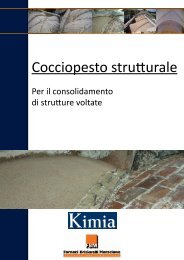PARTE II La posa in opera dei manti di copertura in laterizio - Fbm
PARTE II La posa in opera dei manti di copertura in laterizio - Fbm
PARTE II La posa in opera dei manti di copertura in laterizio - Fbm
You also want an ePaper? Increase the reach of your titles
YUMPU automatically turns print PDFs into web optimized ePapers that Google loves.
<strong>La</strong> <strong>di</strong>sposizione degli elementi del manto <strong>di</strong> <strong>copertura</strong><br />
Fig. <strong>II</strong>.38<br />
Sovrapposizione sfalsata tra<br />
coppo <strong>di</strong> coperta e coppo<br />
<strong>di</strong> canale.<br />
Fig. <strong>II</strong>.39<br />
<strong>La</strong> <strong>posa</strong> <strong>dei</strong> coppi muniti <strong>di</strong><br />
dentello <strong>di</strong> arresto avviene,<br />
su una or<strong>di</strong>tura <strong>di</strong> listelli<br />
alla ‘lombarda’, secondo<br />
uno schema <strong>di</strong>agonale<br />
analogo a quello utilizzato<br />
per le tegole. L’impiego <strong>di</strong><br />
ganci consente <strong>di</strong> ancorare<br />
tra loro gli elementi<br />
impedendone il reciproco<br />
spostamento.<br />
84 I MANTI DI COPERTURA IN LATERIZIO<br />
Se l’or<strong>di</strong>tura <strong>di</strong> supporto è ‘alla<br />
lombarda’, e cioè con i listelli <strong>di</strong><br />
supporto paralleli alla l<strong>in</strong>ea <strong>di</strong><br />
gronda, tale valutazione deve essere<br />
effettuata preventivamente durante<br />
il posizionamento <strong>dei</strong> listelli.<br />
Dopo questa prima <strong>opera</strong>zione, <strong>in</strong>izia la <strong>posa</strong><br />
della prima fila orizzontale <strong>di</strong> coppi <strong>di</strong> canale,<br />
<strong>in</strong> corrispondenza della l<strong>in</strong>ea <strong>di</strong> gronda,<br />
sulla quale si <strong>posa</strong>no successivamente i coppi<br />
<strong>di</strong> coperta <strong>in</strong>iziando con una prima fila <strong>di</strong><br />
coppi tagliati a 3/4 della lunghezza: tale sfalsamento<br />
comporta che, nelle file successive, la<br />
parte superiore del coppo <strong>di</strong> coperta vada a costituire<br />
battuta per il coppo <strong>di</strong> canale sovrastante. Tale <strong>di</strong>sposizione<br />
offre una maggiore garanzia contro le <strong>in</strong>filtrazioni<br />
<strong>di</strong> acqua e consente, fissando i coppi <strong>di</strong> coperta, <strong>di</strong><br />
bloccare anche quelli <strong>di</strong> canale.<br />
<strong>La</strong> <strong>posa</strong> <strong>dei</strong> coppi muniti <strong>di</strong> dentello <strong>di</strong> arresto avviene, su una or<strong>di</strong>tura <strong>di</strong><br />
listelli alla ‘lombarda’, secondo uno schema <strong>di</strong>agonale analogo a quello utilizzato<br />
per le tegole portoghesi o olandesi.





